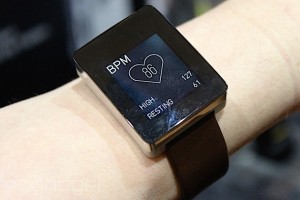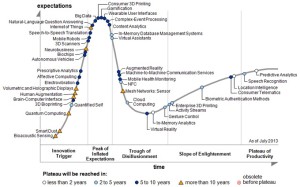 There’s a growing number of wearable digital health devices on the market, and more will appear at the 2015 Consumer Electronics Show in Las Vegas. Four new such products competed live today at CE Week’s Battle of the Bands, an event launched by Living in Digital Times. The competitors included GoQii, Healbe, Skulpt, and Wellograph,
There’s a growing number of wearable digital health devices on the market, and more will appear at the 2015 Consumer Electronics Show in Las Vegas. Four new such products competed live today at CE Week’s Battle of the Bands, an event launched by Living in Digital Times. The competitors included GoQii, Healbe, Skulpt, and Wellograph,
 Wellograph calls itself “the world’s first wellness watch.” Made of sapphire crystal, the watch has a sleek design, targeting a working professional audience who wants a view on health throughout the day. The watch has an Integrated heart rate sensor, taking readings from the wrist for pulse, fitness, workouts, steps and more. All information is stored on the device, which also has an app for tracking personal info over time. It will ship in August 2014 for $349 retail.
Wellograph calls itself “the world’s first wellness watch.” Made of sapphire crystal, the watch has a sleek design, targeting a working professional audience who wants a view on health throughout the day. The watch has an Integrated heart rate sensor, taking readings from the wrist for pulse, fitness, workouts, steps and more. All information is stored on the device, which also has an app for tracking personal info over time. It will ship in August 2014 for $349 retail.
 Healbe positions itself as a 100% automatic body manager. GoBe is more than a fitness tracker – it gauges whole body health, monitoring: calorie intake, output, hydration, stress levels, and more — taking information right from the body via 3 sensors. Calorie intake using the impedence sensor is a differentiator for this product in this field. Using it “allows you to #GoBeYou,” the firm’s marketing rep told the audience.
Healbe positions itself as a 100% automatic body manager. GoBe is more than a fitness tracker – it gauges whole body health, monitoring: calorie intake, output, hydration, stress levels, and more — taking information right from the body via 3 sensors. Calorie intake using the impedence sensor is a differentiator for this product in this field. Using it “allows you to #GoBeYou,” the firm’s marketing rep told the audience.
 GoQii considers itself a health ecosystem, with several touchpoints: coaching, gamification, motivation, habit formation, goal reinforcement, fitness tracking, and for a change-up — philanthropy, or karma. By engaging in fitness goals, GoQii tracks activity and for every 390 steps, the “player” (in GoQii speak) earns one karma point which can be used as currency to spend on philanthropic causes (Oxfam was mentioned as an example). The actual GoQii wristband is free. The health coaching costs $149 for the first six months, and $200 thereafter. GoQii has about 800 users today.
GoQii considers itself a health ecosystem, with several touchpoints: coaching, gamification, motivation, habit formation, goal reinforcement, fitness tracking, and for a change-up — philanthropy, or karma. By engaging in fitness goals, GoQii tracks activity and for every 390 steps, the “player” (in GoQii speak) earns one karma point which can be used as currency to spend on philanthropic causes (Oxfam was mentioned as an example). The actual GoQii wristband is free. The health coaching costs $149 for the first six months, and $200 thereafter. GoQii has about 800 users today.
 Skulpt is in the business of helping you create “a better u.” Its focus is on quality muscle, not body weight. The Skulpt team lobbies against using a scale which it called “1940s technology.” (Aside: don’t tell Withings, a sponsor of CE Week, that). The Skulpt Aim was developed to replace Old School body calipers, monitoring body fat percentage and muscle gained. “The higher your MQ the stronger you are,” Skulpt believes. Essentially, Skulpt measures visceral fat, and is essentially a body composition and muscle quality analyzer.
Skulpt is in the business of helping you create “a better u.” Its focus is on quality muscle, not body weight. The Skulpt team lobbies against using a scale which it called “1940s technology.” (Aside: don’t tell Withings, a sponsor of CE Week, that). The Skulpt Aim was developed to replace Old School body calipers, monitoring body fat percentage and muscle gained. “The higher your MQ the stronger you are,” Skulpt believes. Essentially, Skulpt measures visceral fat, and is essentially a body composition and muscle quality analyzer.
The winner of The Battle for CE Week? Healbe, the all-in body analyzer.
 Health Populi’s Hot Points: The supply side of digital health is so hot that the footprint at CES 2014 grew 40% over 2013 at the Las Vegas Convention Center, and that was on top of 25% growth in 2012. In 2015, the footprint will be enlarged by projects like these who “battled” here in NYC today, as well as in smartwatches new to health and fitness, and new on-ramps to self-tracking emerging from Apple, Google, Samsung, WebMD, and Microsoft, among many others. I continue to refer to Gartner’s Hype Cycle showing wearables at the apex of the curve — the so-called Peak of Inflated Expectations in Gartner’s terms, show in the graphic.
Health Populi’s Hot Points: The supply side of digital health is so hot that the footprint at CES 2014 grew 40% over 2013 at the Las Vegas Convention Center, and that was on top of 25% growth in 2012. In 2015, the footprint will be enlarged by projects like these who “battled” here in NYC today, as well as in smartwatches new to health and fitness, and new on-ramps to self-tracking emerging from Apple, Google, Samsung, WebMD, and Microsoft, among many others. I continue to refer to Gartner’s Hype Cycle showing wearables at the apex of the curve — the so-called Peak of Inflated Expectations in Gartner’s terms, show in the graphic.
Consumer demand – that is peoples’ willingness-to-pay out of pocket hard, after-tax dollars from disposable income — will determine which of these devices and tools — whether wrist-worn, thrown into a pocket, or mobile phone driven — will survive to be featured in a booth at the 2016 CES. For now, let’s remember the sobering fact that only a few percent of people in the U.S. use digital devices to track their health.
Me? I’ve been tracking for over four years, and am still trying to crack the calorie/food mash-up. That’s the lsat-mile in self-tracking for the masses, the way I look at this segment. Healbe will publish data in August 2014 about how well its calorie tracking/impedence sensor is doing — which I am keen to follow.




 Interviewed live on BNN Bloomberg (Canada) on the market for GLP-1 drugs for weight loss and their impact on both the health care system and consumer goods and services -- notably, food, nutrition, retail health, gyms, and other sectors.
Interviewed live on BNN Bloomberg (Canada) on the market for GLP-1 drugs for weight loss and their impact on both the health care system and consumer goods and services -- notably, food, nutrition, retail health, gyms, and other sectors. Thank you, Feedspot, for
Thank you, Feedspot, for  As you may know, I have been splitting work- and living-time between the U.S. and the E.U., most recently living in and working from Brussels. In the month of September 2024, I'll be splitting time between London and other parts of the U.K., and Italy where I'll be working with clients on consumer health, self-care and home care focused on food-as-medicine, digital health, business and scenario planning for the future...
As you may know, I have been splitting work- and living-time between the U.S. and the E.U., most recently living in and working from Brussels. In the month of September 2024, I'll be splitting time between London and other parts of the U.K., and Italy where I'll be working with clients on consumer health, self-care and home care focused on food-as-medicine, digital health, business and scenario planning for the future...